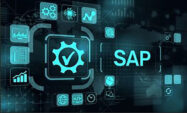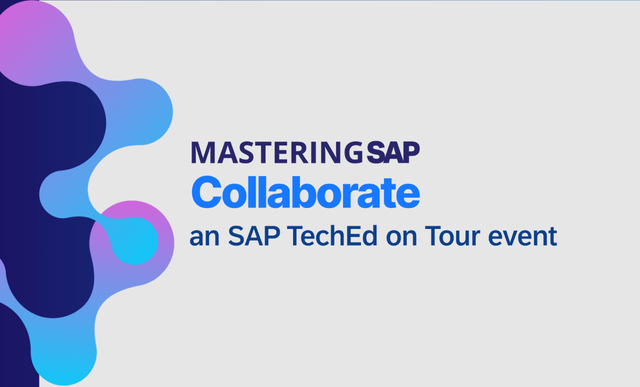SAP Process Orchestration
Filter By
Browse By
- SAP Analytics and AI
- SAP Application Development and Integration
- All SAP Application Development and Integration
- SAP ABAP
- SAP ABAP Development Tools
- SAP ABAP Test Cockpit
- SAP API Management
- SAP BAPI
- SAP Basis
- SAP BRF
- SAP Business Application Studio
- SAP CMS
- SAP Design Studio
- SAP Development Tools
- SAP DevOps
- SAP EAI
- SAP EDI
- SAP Extension Suite
- SAP Fiori
- SAP Fiori Elements
- SAP Integration Suite
- SAP Low Code Application Development
- SAP Low Code Automation
- SAP Netweaver
- SAP Release Management
- SAP UI5
- SAP Web Application Server
- SAP Web IDE
- SAP Business Process Management
- SAP Center of Excellence
- SAP CIO
- SAP Customer Experience
- SAP Data and Data Management
- All SAP Data and Data Management
- SAP BW
- SAP BW/4HANA
- SAP Crystal Reports
- SAP Data Archiving
- SAP Data Center
- SAP Data Governance
- SAP Data Integration
- SAP Data Migration
- SAP Data Quality
- SAP Data Services
- SAP Data Strategy
- SAP Data Visualization
- SAP Data Warehouse Cloud
- SAP DMS
- SAP Document Control
- SAP EIM
- SAP ETL
- SAP ETL Tools
- SAP HANA
- SAP HANA Administration
- SAP HANA Deployment Infrastructure
- SAP HANA Studio
- SAP Master Data
- SAP Master Data Governance
- SAP MDM
- SAP Enterprise Architect
- SAP Enterprise Asset Management
- SAP ERP
- SAP Finance
- All SAP Finance
- SAP Accounting
- SAP AR AP
- SAP Asset Accounting
- SAP Billing Systems
- SAP BPC
- SAP BRIM
- SAP Cash Management
- SAP Central Finance
- SAP Controlling
- SAP COPA
- SAP Cost Center Accounting
- SAP Currency Risk
- SAP e-invoicing
- SAP FICO
- SAP Finance Automation
- SAP Advanced Financial Closing
- SAP Financial Consolidation
- SAP Financial Planning
- SAP FX Risk
- SAP General Ledger
- SAP Global Tax Management
- SAP Hyperion
- SAP Order to Cash
- SAP Payment Processing
- SAP Profitability Analysis
- SAP Rebate Management
- SAP S/4HANA Finance
- SAP SWIFT Compliance
- SAP Treasury Management
- SAP Universal Journal
- SAP Governance Risk and Compliance
- SAP Human Capital Management
- SAP Intelligent Technologies
- SAP Platform and Technology
- All SAP Platform and Technology
- SAP Business Technology Platform
- SAP Cloud
- SAP Cloud Connector
- SAP Cloud Integration Platform
- SAP Cloud Migration
- SAP Cloud Platform
- SAP Cloud Providers
- SAP Cloud Strategy
- SAP Digital Signature
- SAP Container Platform
- SAP HANA Enterprise Cloud
- SAP Digital Asset Management
- SAP Smart Forms
- SAP HEC
- SAP Digital Integration Hub
- SAP Hyperscalers
- SAP Infrastructure
- SAP Messaging
- SAP Quality and Testing
- SAP Security
- SAP Spend Management
- SAP Supply Chain Management
- All SAP Supply Chain Management
- SAP APO
- SAP Asset Management
- SAP Business Network
- SAP Digital Manufacturing Cloud
- SAP Digital Twin
- SAP EWM
- SAP IBP
- SAP Inventory Management
- SAP Label Printing
- SAP Logistics
- SAP Manufacturing
- SAP Manufacturing Automation
- SAP MES
- SAP MII
- SAP MM
- SAP MRO
- SAP MRP
- SAP Order Management
- SAP Plant Maintenance
- SAP PLM
- SAP Production Planning
- SAP S&OP
- SAP SD
- SAP SPM
- SAP Supply Chain Planning
- SAP Track and Trace
- SAP Transportation Management
- SAP System Administration
What is Process Orchestration?
Businesses run on a plethora of business processes. In today’s rapidly digitizing world, it means that they may need to be supported by a multitude of systems. To build best-of-breed processes, organizations need to understand their current state better and make sure that it’s well orchestrated. While point systems may be capturing data, this data is fragmented and does not provide a holistic view of the end-to-end data flow. Process orchestration ensures that these disparate data sources work in sync with each other, when required, with data sharing and a combined intelligence and analytics platform. This provides organizations with the required insights to reduce friction, identify efficiency opportunities, and build best-in-class processes within a combined portfolio.
What is Process Orchestration?
Businesses run on a plethora of business processes. In today’s rapidly digitizing world, it means that they may need to be supported by a multitude of systems. To build best-of-breed processes, organizations need to understand their current state better and make sure that it’s well orchestrated. While point systems may be capturing data, this data is fragmented and does not provide a holistic view of the end-to-end data flow. Process orchestration ensures that these disparate data sources work in sync with each other, when required, with data sharing and a combined intelligence and analytics platform. This provides organizations with the required insights to reduce friction, identify efficiency opportunities, and build best-in-class processes within a combined portfolio.
Examples of Process Orchestration Tools Available in SAP ecosystem
There are several process orchestration tools available in the SAP ecosystem. SAP’s acquisition of Signaviolast year illustrates the growing importance of process intelligence. Due to the rising importance, there are now several vendors in this space, including key ones like SAP, Celonis, Kofax, UiPath, IBM, and Worksoft. Some of these vendors offer a comprehensive solution that encompasses a wide range of business processes whereas others are focused on a subset of processes.
Key Considerations for SAPinsiders
- Develop a process orchestration strategy. This is a step you need to finalize even before you start evaluating tools you need. The first sub-step is to understand which processes are interconnected and hence need to be in sync and orchestrated. The second sub-step is to define how this orchestrated capability will interface with other applications like your business intelligence tools or control towers. You then also need to understand the role analytics will play in your process intelligence strategy.
- Understand the strengths of orchestration tools available. While they all fall into the same category, these tools have different unique selling propositions. It is imperative for you to understand these strengths as that will aid you to understand which tools will fit your needs. A good approach is to evaluate use cases like this to understand if the tool has been leveraged extensively in your domain.
- Leverage tools beyond vanilla process intelligence. Leverage tools for initiatives beyond day-to-day process intelligence. SAP S/4HANA migration is a great example, considering that organizations see this as a challenging initiative. As detailed in this white paper, a process mining and intelligence platform can help you capture your current processes to facilitate and accelerate the migration.
252 results
-

RISE with SAP Methodology: The Advantage of Adopting SAP’s Integrated Toolchain
Reading time: 3 mins
The Integrated Toolchain of RISE with SAP, featuring tools like LeanIX, SAP Signavio, and Tricentis, aims to streamline migrations by improving risk management and accelerating time to value.
-

Tutorial: How to Add SAP to an AI Agent’s Toolbox in Camunda
Reading time: 1 min
The article discusses how Camunda’s open and composable architecture facilitates the integration of SAP systems with AI agents, enhancing data interaction and improving the utility of basic SAP functionalities while minimizing the need for manual data retrieval.
-

Why We Developed a Camunda SAP Integration Solution
Reading time: 4 mins
Announcing our new SAP integration: find out what inspired us to build the solution, how it works and what you can expect (hint: flexibility, speed and reduced risk).
-
-

Transforming Manufacturing from Shop Floor Chaos to a Smart Factory
Reading time: 3 mins
A Manufacturing Execution System (MES) integrates with the Industrial Internet of Things (IIoT) to create a real-time, intelligent factory environment that enhances planning, execution, and dynamic scheduling, ultimately transforming disconnected operations into a cohesive, self-adaptive system.
-

The CFO’s AI Playbook: Unleashing Next-Gen Financial Operations with Generative AI & ML in SAP S/4HANA
Reading time: 6 mins
The evolving role of the CFO now emphasizes strategic value creation through AI and ML integration in financial operations, as outlined in The SAP CFO’s AI Playbook, which guides leveraging these technologies within SAP S/4HANA to enhance efficiency, decision-making, and consultant responsibilities in an increasingly automated landscape.
-

Modern Workload Automation Proves Key to Unlocking SAP ROI
Reading time: 2 mins
Workload automation (WLA) is critical for enterprise IT, yet many organizations still rely on outdated job schedulers that limit innovation and increase costs, prompting a shift towards modern, cloud-based automation solutions which enhance efficiency and reduce operational risks.
-

From Data Bottleneck to Self-Service: How AI Transforms SAP Analytics Access
Reading time: 3 mins
PlatinumDB transformed SAP data analytics for a client by implementing a modern data stack with conversational AI integrated into Microsoft Teams, enabling real-time, self-service access to insights that reduced reporting cycles from weeks to minutes while maintaining governance and security. Membership Required You must be a member to access this content.View Membership LevelsAlready a member?…
-
-

Why Legacy Workload Automation Is Blocking SAP Digital Initiatives
Reading time: 2 mins
Workload automation is critical for IT efficiency, yet many enterprises cling to outdated tools which complicate digital transformation and elevate risks, urging a shift towards modern, cloud-ready solutions like RunMyJobs to enhance performance and align IT with business goals.
-

NetApp Introduces AI-Powered Ransomware Protection at Storage Layer
Reading time: 2 mins
NetApp’s BlueXP ransomware protection, now in public preview, offers a comprehensive, automated solution that enhances cybersecurity by enabling rapid detection and response to ransomware attacks at the storage layer.
-

- SAP Fiori
 Premium
Premium
Video: Expert Interview on SAP Fiori with Arghadip Kar
A positive user experience is table stakes for today’s software. SAP Fiori provides that positive, radically new user experience for SAP applications. SAP Fiori provides thousands of pre-configured applications that assemble legacy transaction codes, and overlay with “persona-based” user experience. While the benefits are very clear, adopting the right SAP Fiori applications for the right personas...…
Become a Member
Unlimited access to thousands of resources for SAP-specific expertise that can only be found here.
Become a Partner
Access exclusive SAP insights, expert marketing strategies, and high-value services including research reports, webinars, and buyers' guides, all designed to boost your campaign ROI by up to 50% within the SAP ecosystem.
Upcoming Events
-

Mastering SAP Collaborate, an SAP TechEd on Tour event
November 12 - 14, 2025
Sydney, New South Wales
Australia
View Event
Related Vendors
Your request has been successfully sent

